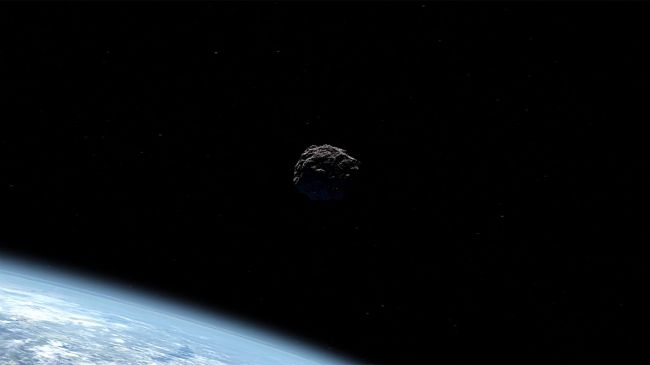When it comes to mining space for water, the best target may not be the moon: Entrepreneurs’ richest options are likely to be asteroids that are larger and closer to Earth.
Source: Space.com
A recent study suggested that roughly 1,000 water-rich, or hydrated, asteroids near our planet are easier to reach than the lunar surface is. While most of these space rocks are only a few feet in size, more than 25 of them should be large enough to each provide significant water. Altogether, the water locked in these asteroids should be enough to fill somewhere around 320,000 Olympics-size swimming pools — significantly more than the amount of water locked up at the lunar poles, the new research suggested.
Because asteroids are small, they have less gravity than Earth or the moon do, which makes them easier destinations to land on and lift off from. If engineers can figure out how to mine water from these space rocks, they could produce a source of ready fuel in space that would allow spacecraft designers to build refuelable models for the next generation of satellites. Asteroid mining could also fuel human exploration, saving the expense of launching fuel from Earth. In both cases, would-be space-rock miners will need to figure out how to free the water trapped in hydrated minerals on these asteroids.
“Most of the hydrated material in the near-Earth population is contained in the largest few hydrated objects,” Andrew Rivkin, an asteroid researcher at Johns Hopkins University Applied Physics Research Laboratory in Maryland, told Space.com. Rivkin is the lead author on the paper, which estimated that near Earth asteroids could contain more easily accessible water than the lunar poles.
“A sure thing”
According to the United Nations Office for Outer Space Affairs, more than 5,200 of the objects launched into space are still in orbit today. While some continue to function, the bulk of them buzz uselessly over our heads every day. They carry fuel on board, and when they run out, they are either lowered into destructive orbits or left to become space junk, useless debris with the potential to cause enormous problems for working satellites. Refueling satellites in space could change that model, replacing it with long-lived, productive orbiters.
“It’s easier to bring fuel from asteroids to geosynchronous orbit than from the surface of the Earth,” Rivkin said. “If such a supply line could be established, it could make asteroid mining very profitable.”
Hunting for space water from the surface of the Earth is challenging because the planet’s atmosphere blocks the wavelength of light where water can be observed. The asteroid warming as it draws closer to the sun can also complicate measurements.
Instead, Rivkin and his colleagues turned to a class of space rocks called Ch asteroids. Although these asteroids don’t directly exhibit a watery fingerprint, they carry the telltale signal of oxidized iron seen only on asteroids with signatures of water-rich minerals, which means the authors felt confident assuming that all Ch asteroids carry this rocky water.
Based on meteorite falls, a previous study estimated that Ch asteroids could make up nearly 10% of the near-Earth objects (NEOs). With this information, the researchers determined that there are between 26 and 80 such objects that are hydrated and larger than 0.62 miles (1 km) across.
Right now, only three NEOs have been classified as Ch asteroids, although others have been spotted in the asteroid belt. Most NEOs are discovered and observed at wavelengths too short to reveal the iron band that marks the class. Carbon-rich asteroids, which include Ch asteroids and other flavors, are also darker than the more common stony asteroids, making them more challenging to observe.
Although Ch asteroids definitely contain water-rich minerals, that doesn’t necessarily mean that they will always be the best bet for space mining. It comes down to risk. Would an asteroid-mining company rather visit a smaller asteroid that definitely has a moderate amount of water, or a larger one that could yield a larger payday but could also come up dry?
“Whether getting sure things with no false positives, like the Ch asteroids, is more important or if a greater range of possibilities is acceptable with the understanding that some asteroids will be duds is something the miners will have to decide,” Rivkin said.
Not too big, not too small
In addition to estimating the number of large, water-rich asteroids might be available, the study also found that as many as 1,050 smaller objects, roughly 300 feet (100 meters) across, may also linger near Earth. Their small bulk will make them easier to mine because their low gravity will require less fuel to escape from, but they will produce less water overall, and Rivkin expects that the handful of larger space rocks will be the first targets.
“It seems likely that the plan for these companies will be to find the largest accessible asteroid with mineable material with the expectation that it will be more cost-effective than chasing down a large number of smaller objects,” Rivkin said. “How ‘accessible’ and ‘mineable material’ and ‘cost-effective’ are defined by each company is to be seen.”
But asteroids will certainly be more accessible than the moon, another potential source of space-based water-rich minerals. According to Rivkin, landing safely on the lunar surface takes more than a hundred times the change of velocity required to land on an asteroid. Similarly, taking off from the moon means breaking free from its gravity, requiring even more fuel. “Even asteroids that are a bit farther from the Earth than the moon can be reached with less fuel than the lunar surface,” Rivkin said.
The research is described in a paper published in December 2018 in the Journal of Geophysical Research: Planets.

































Leave a Comment
You must be logged in to post a comment.